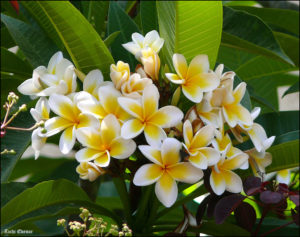 Plumerias are members of the Dogbane family and are native to Tropical America. A plumeria grows as a shrub or small tree and can be kept in a container on the patio or by the pool or in the garden, and brought indoors for the winter.
Plumerias are members of the Dogbane family and are native to Tropical America. A plumeria grows as a shrub or small tree and can be kept in a container on the patio or by the pool or in the garden, and brought indoors for the winter.
How to Take Care of Your Plumeria
Plumerias require at least a half-day of direct sun to flower, but perform best in full sun. Keep the soil evenly moist during the summer growing season, but allow some drying to occur in between thorough waterings. Avoid soggy conditions at all times, as this could lead to root rot. On the other hand, excessive dryness will result in yellow leaves and foliage loss. There is a happy middle ground to maintain.
A regular fertilization program with a formulation high in phosphorus (the middle number) will produce vigorous plants with large clusters of flowers that generally appear from early summer into fall. “NutriStar for Plumeria” fertilizers from Nelson Plant Food give excellent results. Avoid fertilizers high in nitrogen, which tend to produce leggy plants with few blooms.
Plumerias are very sensitive to frost and should be moved inside when night temperatures fall below 40 degrees F. If conditions indoors are bright enough to allow for continued growth, provide water on a regular basis, but only after the soil becomes moderately dry.
If conditions are less than ideal, allow the plant to go dormant for the remainder of winter. Place it in a storage area where the temperature remains just above 40 degrees F. During this time, plumerias require no water or light. All the leaves will be shed and the plant will resemble a defoliated tree limb or a stick, and will rest until spring.
How do I get rid of insects on my Plumeria?
Plumerias are fairly resistant to insects and diseases, though spider mites will sometimes infest buds and new growth, especially indoors when conditions are hot and the humidity is low. Spider mites can be controlled with forceful sprays of cool water that are strong enough to knock them from the plant. If need be, low toxicity sprays such as insecticidal soap solutions, and horticultural molasses are also effective.
Young plants may be shy bloomers, so be patient for a few years until the cutting matures. But when they mature; what an amazing show you will get.